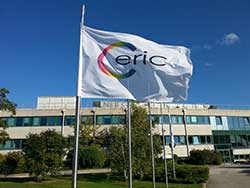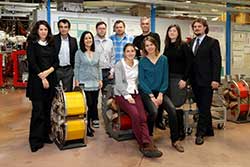CERIC-ERIC, a new Central European Research Infrastructure
Nicoletta Carboni



A part of the team working in CERIC-ERIC
CERIC-ERIC is a distributed research facility, set up as a European Research Infrastructure Consortium (ERIC) by Austria, Czech Republic, Italy, Romania, Serbia, Slovenia and additionally with the support of Croatia, Hungary and Poland. The CERIC mission is to offer an integrated multi-technique service to researchers from all over the world.
Materials sciences, life sciences and nanotechnology are among the research fields with a large innovative potential. The scientific problems emerging in these fields have become more and more complex in recent years and require access and expertise in an ever increasing number of different analytical and synthesis techniques and a multi-probe and multidisciplinary approach. CERIC responds to these requirements.
CERIC-ERIC entered operation in 2014 through two successful international calls for proposals. It offers to researchers with the best proposals a coordinated and open access to the best facilities in the participating countries. These are facilities already operating in structural investigation and imaging of materials and biomaterials down to the nanoscale, by photon, electron, neutron and ion based techniques. They are complemented by preparation facilities in structural biology, photolithography and materials preparation.
The reason why Research Ministers have approved this single Institution is that they have understood that, by opening access only on the basis of quality, their countries would achieve three main goals: the construction of a Research Infrastructure with unique capabilities and quality at world level, the attraction of international researchers in the area, and the benchmarking of the local researchers and research facilities against the top quality ones at world level. Furthermore, this approach is the best to achieve improvement also in education and in potential industrial returns.
Several facilities for the analysis and synthesis of materials are already present in the world, but they cover a relatively narrow range of techniques and, in the case of Europe, are mostly localized in Western Europe. CERIC, being distributed in Central-Eastern Europe, fosters a greater attraction of researchers in this area. It accelerates excellence and innovation and, last but not least, European integration.
CERIC operates as a Consortium and has set up an open-access, single entry-point to one Partner Facility in each Country. All participating laboratories have been evaluated and approved by an international independent expert committee (the International Evaluation Committee, I-EvCo), and will submit to regular evaluations in the future.
Currently, the instruments and laboratories available within CERIC-ERIC are:- The Institute of Inorganic Chemistry (Graz University of Technology, Austria) with expertise in structural characterization and preparation of materials for energy and bio-films for biosensors, offering light scattering laboratories and access to the Austrian SAXS beamline at Elettra.
- The Tandem van de Graaff accelerator facility (Ruđer Bošković Institute, Zagreb, Croatia) entirely dedicated to the development and applications of ion beam techniques for materials modification and characterization, such as PIXE and RBS, as well as heavy ion microprobe, dual beam irradiation chamber with RBS/channeling, and TOF ERDA spectrometer.
- The Surface Physics laboratory (SPL, Charles University in Prague, Czech Republic) with expertise in surface analysis, thin film growth and studies of reaction mechanisms on catalyst surfaces and biosensors. SPL offers 4 ultra-high vacuum systems with XPS, ion scattering spectroscopy and low energy electron diffraction optics, and access to the Czech Materials Science Beamline at Elettra.
- The Centre for Energy Research (Hungarian Academy of Sciences, Budapest Neutron Centre, Hungary) performing R&D in nuclear science and technology, studying the interaction of radiation with matter, and doing isotope and nuclear chemistry, chemical analysis with nuclear methods, radiography, radiation chemistry, radiation protection and nuclear security, renewable energy research, surface chemistry and catalysis.
- Elettra Sincrotrone (Trieste, Italy), a multidisciplinary laboratory generating high quality synchrotron and free-electron laser light for scientific applications.
- The Laboratory of Atomic Structures and Defects in Advanced Materials (National Institute of Material Physics, Bucharest, Romania) with HRTEM and EPR laboratories for research in solid state physics and materials science, including the synthesis and characterization of advanced materials for applications in microelectronics, catalysis, energy industry and ICT.
- The Slovenian NMR Centre (National Institute of Chemistry in Ljubljana, Slovenia) with NMR spectroscopy for chemical analysis and identification, for determining 3D structures and studying the dynamics of small and larger bio-macro-molecules, for tracking chemical reactions in analytical and bioanalytical procedures, for studying polycristallinity and identifying metabolites and various amorphous forms.
These facilities, available with open access, are complementary to each other and provide the best possible coverage of the nanoscience and nanotechnology domain, based on high definition probes and techniques.
This multi-technique and interdisciplinary approach spans orders of magnitude in dimension, time resolution and other physicochemical parameters, and gives to users the chance to enter a fertile environment for collaborative projects in a wide range of research areas.
The two international open-access calls for proposals in 2014 have attracted 74 proposals from 15 countries including India and Japan. The next call is expected by the end of February. The deadlines for submitting a proposal and the instruments available for each call will be published on the CERIC-ERIC website.
Nicoletta Carboni is a Communications Fellow at CERIC-ERIC at the Elettra Sincrotrone in Trieste
Disclaimer - The articles and opinion pieces found in this issue of the APS Forum on International Physics Newsletter are not peer refereed and represent solely the views of the authors and not necessarily the views of the APS.
